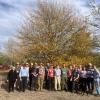Editor's Picks
Plant Focus
Project Contact: Tuyeni Heita Mwampamba, Research Professor Level A, Institute for Ecosystems and Sustainability Research, National Autonomous University of Mexico – Campus Morelia, Mexico.
Mexico is home to approximately 160 species of oak, of which 100 are endemic. Due to its dense properties, oak wood makes excellent charcoal, which is sought in Mexico and abroad for cooking, heating, and barbequing in homes and restaurants. Through the application of conventional and traditional forest management practices to enhance natural regeneration by coppicing, forest owners in Mexico manage their woodlands for charcoal. Oak woodlands and the charcoal sector are thus a significant livelihood stream for tens of thousands of families in rural and urban areas. Indeed, some would even argue that it is thanks to the vibrant and lucrative nature of the charcoal sector that oak woodlands still stand today in a (more or less) conserved state, able to withstand the pressure of more drastic and irreversible land use changes such as their conversion to avocado plantations and grazing lands.
There is genuine interest among forest owners involved in the charcoal sector to understand how their activities and practices might affect long-term forest conservation and what the sector can do to promote diverse, productive, and resilient oak woodlands. There is also interest in developing local capacities to produce oak seedlings for restoring degraded areas. However, there is very little awareness of the global importance of Mexico for oak species conservation and the landowners’ in affecting oak conservation. Additionally, local capacity to reliably identify species, monitor them across space and time, and process the information in order to identify threats and design management response is low. With more than 70% of forests in Mexico under private and community ownership, oak conservation relies on the willingness and interest of local landowners and on their ability to generate locally relevant data for informing their decisions.
The project’s aim is to generate information that forest owners involved in the charcoal sector need to make informed decisions about how to enhance oak conservation on their land. It will be carried out in one pilot site located in the State of Guanajuato, Mexico in the Santa Rosa de Lima Highlands belonging to one of the largest charcoal producers in the area. Our scientists-practitioner collaborative approach is aimed at co-designing and implementing an oak-monitoring program grounded on scientific and local knowledge.
Envisioned as the first step towards long-term monitoring of biodiversity in charcoal production areas, the monitoring data will be used to: a) improve current understanding of the status of oaks in the study area and the effect of charcoal production on species composition, health, seed production, and other population characteristics, b) develop management responses to identified threats, c) raise awareness locally and nationally on oak conservation in managed woodlands and d) plan a local nursery to test seed germination and explore the potential to generate seedlings locally for restoring degraded sites.
Further Reading
Project Report
Tuyeni H. Mwampamba, Project Lead
Submitted March 10, 2023


















